Global Humanitarian Assistance Report 2023: Chapter 1
Key trends in humanitarian need and funding: 2022
DownloadsRead our latest report on humanitarian finance and reform
Our new report 'Falling short? Humanitarian funding and reform' presents the latest data on global humanitarian assistance, as well as progress on Grand Bargain localisation targets, cash and voucher assistance, and anticipatory action.
Read the reportSummary
The scale of global humanitarian crisis significantly worsened in 2022. The number of people assessed to be in need of humanitarian assistance grew by a third, to an estimated 406.6 million people. Humanitarian action had to adapt to new and worsening crises, including conflict in Ukraine, climactic shocks in Pakistan and East Africa, and the ongoing socioeconomic impact of the Covid-19 pandemic. Complex, protracted crises [1] are increasingly the norm with three-quarters of people in need facing at least two risk dimensions of conflict, climate and socioeconomic vulnerability, an increase from 61% in 2021. As a result, a growing majority of people in need (83%) now live in a country experiencing protracted crisis. In his Insight piece, Albashir Ibrahim, Executive Director of NEXUS Consortium in Somalia, comments on the urgent need to build the self-reliance of communities that face these recurrent crises through more joined up humanitarian, development and peace programming.
There was an unprecedented response from both public and private humanitarian donors in 2022, largely driven by support for Ukraine. Total international humanitarian assistance increased by US$10.0 billion (27%) to US$46.9 billion in 2022, a sharp increase in the pace of growth from the previous year. Nearly all of the top 20 public donors increased their contributions in 2022, with over half increasing assistance by more than 20%. Despite this, the humanitarian funding gap grew larger than ever – in 2022 a record US$52.4 billion was requested through UN-coordinated appeals, with the volume of unmet requirements growing to US$22.1 billion. This is only getting worse: to date, requirements for 2023 (US$54.9 billion) have already eclipsed last year and are around 80% higher than requirements before the Covid-19 pandemic in 2019. In his Insight piece, Jan Egeland proposes some potential solutions to the growing funding gap. These go beyond traditional humanitarian actors, including a need to change the narrative around humanitarian assistance as a solely philanthropic venture towards the idea that it is an investment in stability for a common global good.
Rising humanitarian needs, particularly in the fallout of the Russian invasion of Ukraine, mean governments face increasing pressures on their wider aid budgets. There is a real risk that longer-term development funding is both reduced and diverted away from other crises and the poorest countries. In 2022, official development assistance (ODA) spent on hosting refugees in donor countries more than doubled to US$30.1 billion. The proportion of total ODA from Organisation for Economic Co-operation and Development (OECD) Development Assistance Committee (DAC) donors and EU institutions [2] provided as international humanitarian assistance also grew to 17% (US$36.4 billion) from 15% (US$27.9 billion) in 2021.
What is the scale of crisis and need? Risk, vulnerability and protracted crisis
Figure 1.1: Four out of five people in need of humanitarian assistance live in countries experiencing protracted crisis
Map of countries in crisis, 2022

Designed world map showing concentration of countries in protracted across sub-Saharan, Horn of Africa and Middle East. Also shows countries entering crisis – Venezuela, Colombia and Zambia.
Source: Development Initiatives based on UN Office for the Coordination of Humanitarian Affairs (OCHA) Humanitarian Programme Cycle (HPC), INFORM Index for Risk Management, ACAPS, and UN High Commissioner for Refugees (UNHCR).
Notes: CAR = Central African Republic; DPR, Democratic People’s Republic (of Korea); DRC = Democratic Republic of the Congo. Shown only are countries with a UN-coordinated appeal, or more than one million people in need.
Figure 1.2: The number of people affected by humanitarian crisis increased by a third in 2022
Click on the regions below to discover more about people in need, dimensions of risk and funding requirements.
- How many people are in need?
- Is the number increasing?
- What is the level of food insecurity?
- How many years has the country been in protracted crisis?
- Is the country experiencing high conflict risk, high socioeconomic fragility and/or high climate vulnerability?
- What proportion of funding has been met for the country or regional plan?
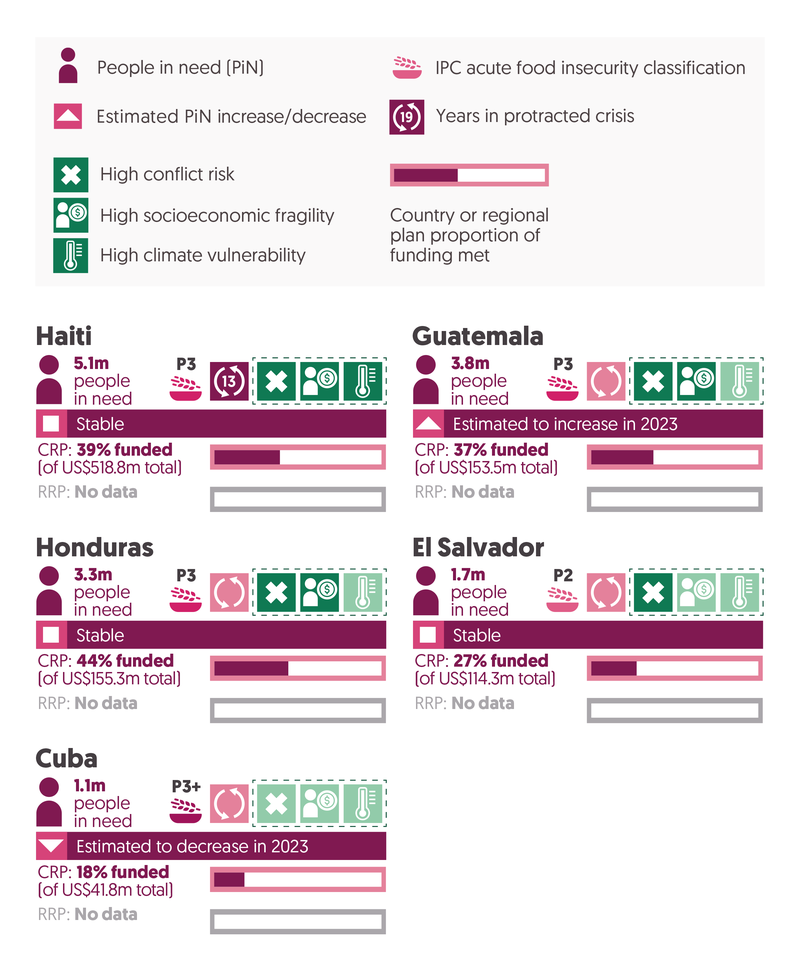
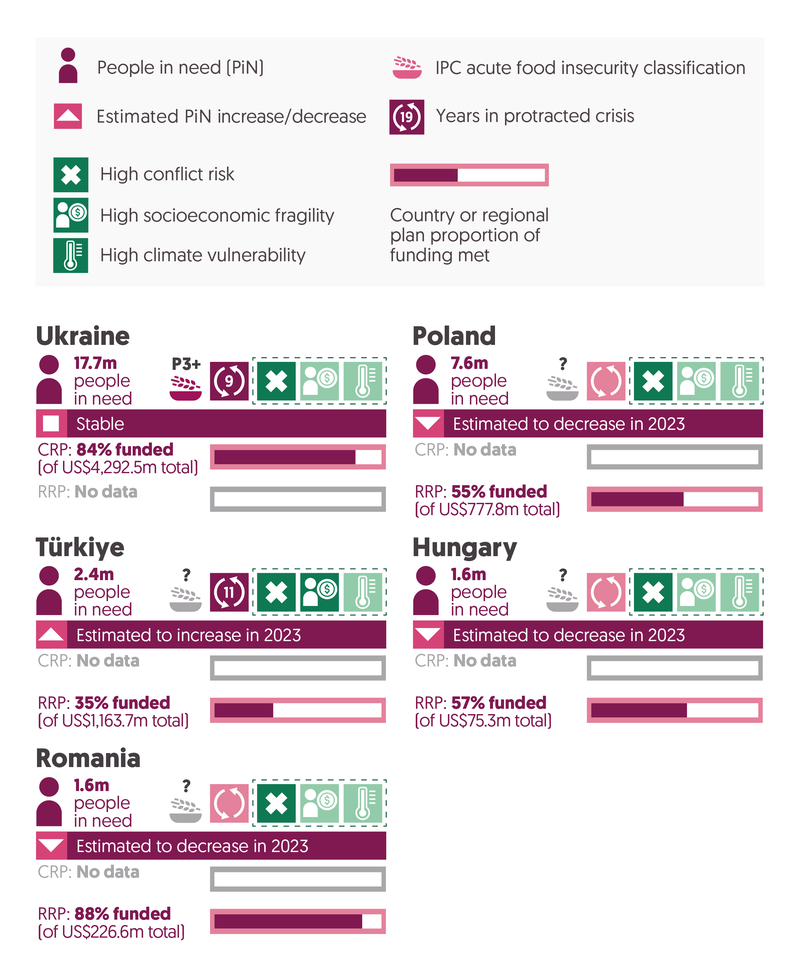
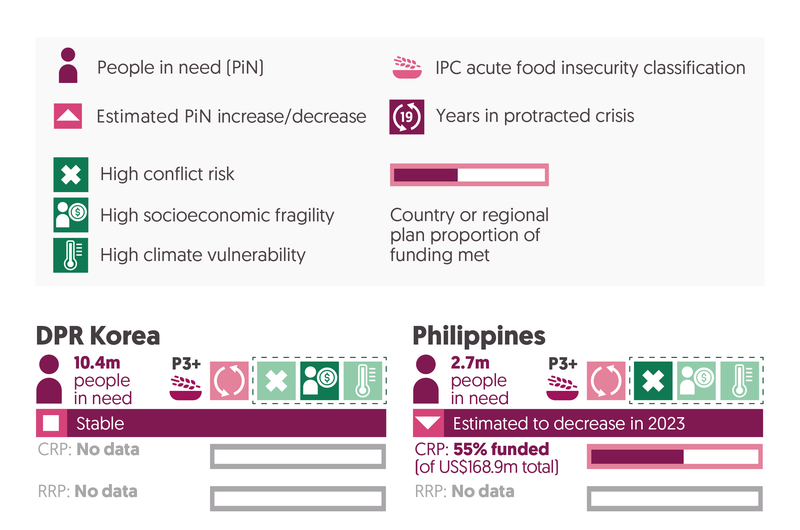


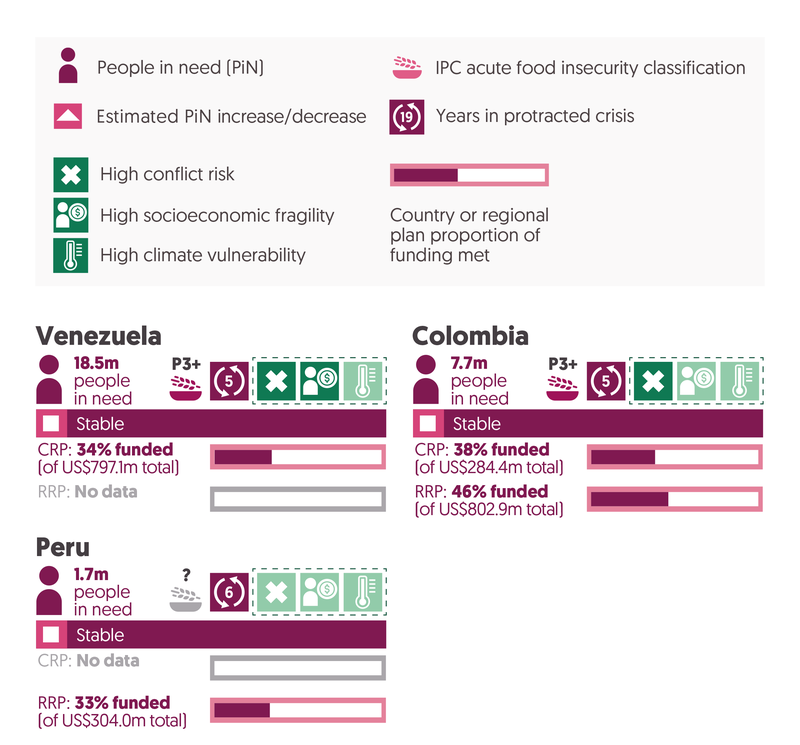
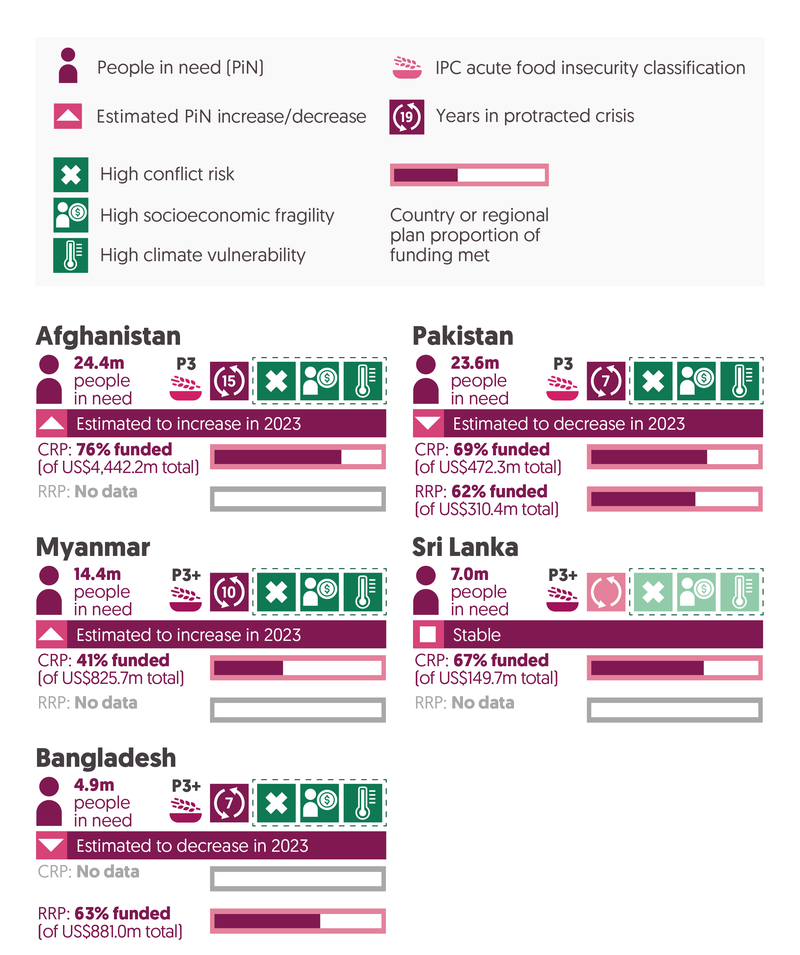

Source: Development Initiatives based on UN Office for the Coordination of Humanitarian Affairs (OCHA) Humanitarian Programme Cycle (HPC), ACAPS, UN High Commissioner for Refugees(UNHCR), INFORM Index for Risk Management, Integrated Food Security Phase Classification (IPC), Heidelberg Institute for International Conflict Research, Notre Dame Global Adaptation Initiative (ND-GAIN), Organisation for Economic Cooperation and Development (OECD) States of Fragility 2022, and UN OCHA Financial Tracking Service (FTS) data.
Notes: CAR = Central African Republic; CRP, country response plan; DPR, Democratic People’s Republic (of Korea); DRC = Democratic Republic of the Congo; RRP, regional response plan. Countries with fewer than an estimated one million people in need are not shown. For further information on coding crisis types, see our online ‘Methodology and definitions’, Chapter 5.
You can also download a PDF of Figure 1.2 , showing all these country cards together, ordered by the total number of people in need. Navigate to the interactive version of this data.
In 2022, long-term, complex crises continued to be the norm, and the number of people requiring humanitarian assistance was greater than ever. New and ongoing conflicts (such as in Ukraine, Myanmar and Ethiopia), climate change-related disasters (such as in Pakistan and the Horn of Africa), and the ongoing socioeconomic fallout from the Covid-19 pandemic (such as in Sri Lanka) drove an increase in the number of countries in crisis. As existing crises within countries continued to deepen, the number of countries experiencing protracted crisis and the number of countries with high levels of humanitarian need also grew in 2022.
- In 2022, an estimated 406.6 million people living in 82 countries were assessed to be in need of humanitarian assistance – continuing a trend of consistent annual growth. This represents an increase of one-third, from 306.0 million people living in 73 countries in 2021, and growth of more than two-thirds (67%), from 243.8 million people in 2020 (excluding needs related to Covid-19).
- More countries than ever are experiencing a protracted crisis. In 2022, 44 of the 82 countries with people in need of humanitarian assistance were experiencing protracted crisis, an increase of eight since 2021. Three of these newly protracted crises have more than one million people in need – Colombia, Venezuela and Zambia.
- As a result, a growing majority of people in need of humanitarian assistance live in countries experiencing protracted crisis. In 2022, the 44 countries experiencing protracted crisis accounted for 83% (339.3 million people) of total people in need – an increase from 2021 when 74% (227.3 million people) of people in need lived in a country facing protracted crisis.
- These crises are not abating – 78 out of the 82 countries in crisis in 2022 had populations assessed to be in need of humanitarian assistance in 2023 (as of April), with 14 countries already recording significant increases of 10% or more.
- The number of countries with high levels of humanitarian need (identified as having more than one million people in need) increased to 51 in 2022, from 49 in 2021.
- To meet these needs, there were 46 UN-coordinated appeals in 2022, similar to 2021 (48 appeals) but still notably higher than in 2019 (36 appeals) before the Covid-19 pandemic.
The widespread increase in the number of people in need was driven both by existing crises worsening and major new crises, particularly in Ukraine, Pakistan and Myanmar, as well as smaller increases in most other countries in need.
- Of the 82 countries with people in need of humanitarian assistance in 2022, more than half (47 countries, 57%) saw an increase in the number of people in need from 2021.
- In total, eight countries saw an increase of more than five million people in need in 2022 and over a quarter (29%, 24 countries) had increases of more than one million people. The largest increases in the numbers of people in need of humanitarian assistance were in Ukraine (increase of 14.3 million people to 17.7 million), Pakistan (increase of 12.6 million to 23.6 million) and Myanmar (increase of 10.7 million to 14.4 million).
- Overall, nine countries newly had people in need of humanitarian assistance in 2022 compared to 2021. Most notable was Poland (7.6 million people) and Sri Lanka (7.0 million people). Only eight countries had a smaller number of people in need of humanitarian assistance compared to 2021, and just one country no longer had any people assessed to need humanitarian assistance.
- High numbers of people in need continue to be concentrated in a small number of countries. More than half (212.8 million) of the people in need in 2022 lived in 10 countries – each with more than 10 million people in need.
- Since 2019, 6 countries have consistently had more than 10 million people in need: Yemen, Syria, Democratic Republic of the Congo, Afghanistan, Venezuela and Democratic People’s Republic of Korea.
Many countries continue to experience complex crises in 2022. Climate-related shocks, for instance the flooding in Pakistan in June 2022 and recurrent droughts in the Horn of Africa, are driving and compounding other risk factors such as conflict and socioeconomic fragility. These shocks erode people’s resilience and ability to recover and increase their need for longer-term humanitarian assistance, undermining efforts to address the root causes of vulnerability. Increasingly the main drivers of humanitarian crisis – conflict, climate and socioeconomic fragility – intersect and overlay one another, with most people in need of humanitarian assistance living in countries experiencing at least two of these risks.
- Three-quarters (75%, 306.9 million) of all people in need of humanitarian assistance in 2022 lived in countries facing at least two of these risk dimensions. This represents a significant rise in both volumes and proportions since 2021 (61%, 187.4 million people).
- More than half (54%, 220.8 million) of all people in need were living in countries facing a combination of all three vulnerabilities.
- The most prevalent dimension was conflict – 87% (354.3 million) of all people in need were living in countries experiencing high-intensity conflict. Also, 85% (343.6 million) were living in socioeconomically fragile countries and 58% (236.7 million) were living in countries with high levels of vulnerability to the impacts of climate change.
A growing number of countries in crisis also have populations facing acute levels of food insecurity, especially those in protracted crisis.
- Of the 82 countries with people in need in 2022, 34 (41%) had populations that were facing at least crisis-level acute food insecurity (Integrated Food Security Phase Classification, IPC, Phase 3+ or equivalent). This is an increase from 27 (37%) of 73 countries in 2021.
- In 2022, two countries – South Sudan and Yemen – had populations that were experiencing emergency-level acute food insecurity (IPC Phase 4), an increase from one country (Afghanistan) in 2021.
Insight
Albashir Ibrahim
Albashir Adan Ibrahim is an international development professional with over 12 years’ experience in humanitarian development. He is the Executive Director for Nexus Consortium Somalia – a platform that brings together eight local organisations from all over Somalia in a bid to transform the humanitarian, development and peace ecosystem through locally led action. He has been extensively involved in a number of areas which include but not limited to, fundraising, institutional development, anticipatory emergency response, research, and peacebuilding in both Somalia and Kenya. He is also the focal person for Somali Humanitarian Hub (SHH).
The need for humanitarian assistance globally has skyrocketed over the last four years or so as more appeals continue to stream in, while funding from donors has not increased. This funding gap will continue to exacerbate the already worsening situation if it is not addressed.
Most of the crises the world is experiencing are caused by armed conflict and climate change and the countries that are experiencing these protracted crises are Somalia, Ukraine, Sudan, Congo, Syria, Bangladesh and Afghanistan, among others. For instance, the long-protracted drought – five failed rainy seasons – in eastern Africa, caused untold suffering on the lives of the communities whose economic mainstay is livestock keeping. The drought was then replaced by a flood crisis, which has already claimed the lives of over twenty people in Somalia. As a result of these unending crises, global needs are rising much faster than donor funding is coming in.
If not addressed, this underfunding will worsen the situation – more people will die of starvation, malnutrition rate will go through the roof, basic infrastructures will be destroyed and domestic and global markets will be on their knees as the situation will take its economic toll on the world. Prices of basic food commodities will exponentially increase. Underfunding could have devastating impacts for millions of people globally – particularly putting children and women at risk, and disrupting essential services such as health, shelter, water and sanitation, and many other programmes.
As Nexus Consortium and focal person for Somali Humanitarian Hub, I believe that for us to find a lasting solution in responding to these protracted crises, we need a humanitarian system that puts the agency and self-reliance of local communities at the centre of its responses and decision-making. The protracted and recurrent crises the world faces need to be addressed by humanitarian responses that look beyond providing immediate humanitarian assistance and instead contribute to building self-reliance of the affected communities. I envision a humanitarian system where locally led humanitarian responses are primary. We should move away from short-term, project-based funding and stop-gap solutions towards a model that integrates humanitarian, development, and peace programming – the triple nexus.
Preparedness and flexibility in dealing with recurrent and sudden-onset crises through the anticipatory and emergency response is a cardinal strategy to avert crises. Humanitarian assistance should aim to decrease the devastating impact of recurring shocks and explicitly focus on building self-reliance and communities’ capacities to withstand or mitigate the impacts of recurrent crises. In doing so, we aim to reduce dependence on humanitarian responses in the future.
Flexible and multi-year funding is another key solution as it gives organisations time to plan and respond to humanitarian needs of the affected populations and make tangible interventions.
Most funding goes to humanitarian response; a paltry sum goes to development. We need to focus on long-term development strategies where we invest heavily in building the resilience of the affected populations instead of always thinking of emergency humanitarian response.
Was humanitarian funding sufficient? Appeals, donors and total assistance
Figure 1.3: International humanitarian assistance from public and private donors grew by over a quarter in 2022
Total international humanitarian assistance, 2018–2022

Stacked column chart showing sharp increase in total international humanitarian assistance in 2022 compared to similar levels for previous 4 years.
Source: Development Initiatives based on Organisation for Economic Co-operation and Development (OECD) Development Assistance Committee (DAC), UN Office for the Coordination of Humanitarian Affairs (OCHA) Financial Tracking Service (FTS), UN Central Emergency Response Fund (CERF) and our unique dataset for private contributions.
Notes: Figures for 2022 are preliminary. Totals for previous years differ from those reported in previous Global Humanitarian Assistance reports due to deflation and updated data. Data is in constant 2021 prices.
Public and private donors both responded exceptionally to the growth in humanitarian needs in 2022 with a sharp increase in the volumes of funding provided. After three years of stagnating funding levels, assistance grew for a second year with the pace of growth rapidly accelerating in 2022.
- In 2022, the estimated total international humanitarian assistance from governments, EU institutions and private donors increased to US$46.9 billion.
- The rate of growth in funding in 2022 significantly increased. Total funding rose by US$10.0 billion from 2021, a 27% increase, compared to the 13% (US$4.2 billion) increase from 2020 to 2021.
This growth was driven by increased contributions from both public and private donors, largely for the response to the conflict in Ukraine.
- Funding from public donors – governments and EU institutions – grew by US$8.0 billion (27%) in 2022, from US$30.1 billion in 2021 to US$38.1 billion.
- Similarly, private donors appear to have responded very strongly to the Ukraine crisis, with estimated contributions increasing by at least US$2.0 billion (29%), from US$6.8 billion to US$8.8 billion. This increase will likely be even greater once more 2022 data becomes available (see our online ‘Methodology and definitions’, Chapter 5 ). This compares to the 17% increase (US$1.0 billion) from private donors in 2020, in response to the Covid-19 pandemic.
The sharp increase in humanitarian needs in 2022 (see Figure 1.4 ), driven by new and worsening crises in Ukraine, Afghanistan and the Horn of Africa, has led to growing pressure on the ODA budgets of countries that give assistance. While total ODA increased in 2022, strong donor solidarity with Ukraine in particular risks development funding being diverted away from other countries in crisis and the poorest countries to support both the humanitarian response in Ukraine and donors’ domestic expenditure on hosting Ukrainian refugees (see Figure 1.5 in this chapter and 2.6 in Chapter 2). This, in addition to a reduction in development aid, undermines efforts to effectively address the root causes of crisis and build long-term resilience (See ‘The triple nexus. What is the mix of humanitarian, development and peace funding reaching countries in crisis?’, Chapter 4 ).
- Preliminary figures show that the total net ODA from OECD DAC members grew by 15% (US$28.4 billion) between 2021 and 2022, from US$185 billion to US$213 billion.
- As a result, both the volume and proportion of ODA provided as international humanitarian assistance grew, with 17% (US$36.4 billion) of total ODA provided as international humanitarian assistance in 2022 compared with 15% (US$27.9 billion) in 2021. [3]
- Significantly more ODA was also spent on the in-country hosting of refugees. The average proportion of total ODA spent on in-country refugee hosting by DAC donors increased from 4.7% in 2021 to 18% in 2022. (See Figure 1.5 ).
Figure 1.4: Despite funding to appeals rising by 40% in 2022 and coverage increasing, the rapid growth in requirements meant the funding shortfall by volume was larger than ever
Funding and unmet requirements, UN-coordinated appeals, 2013–2023
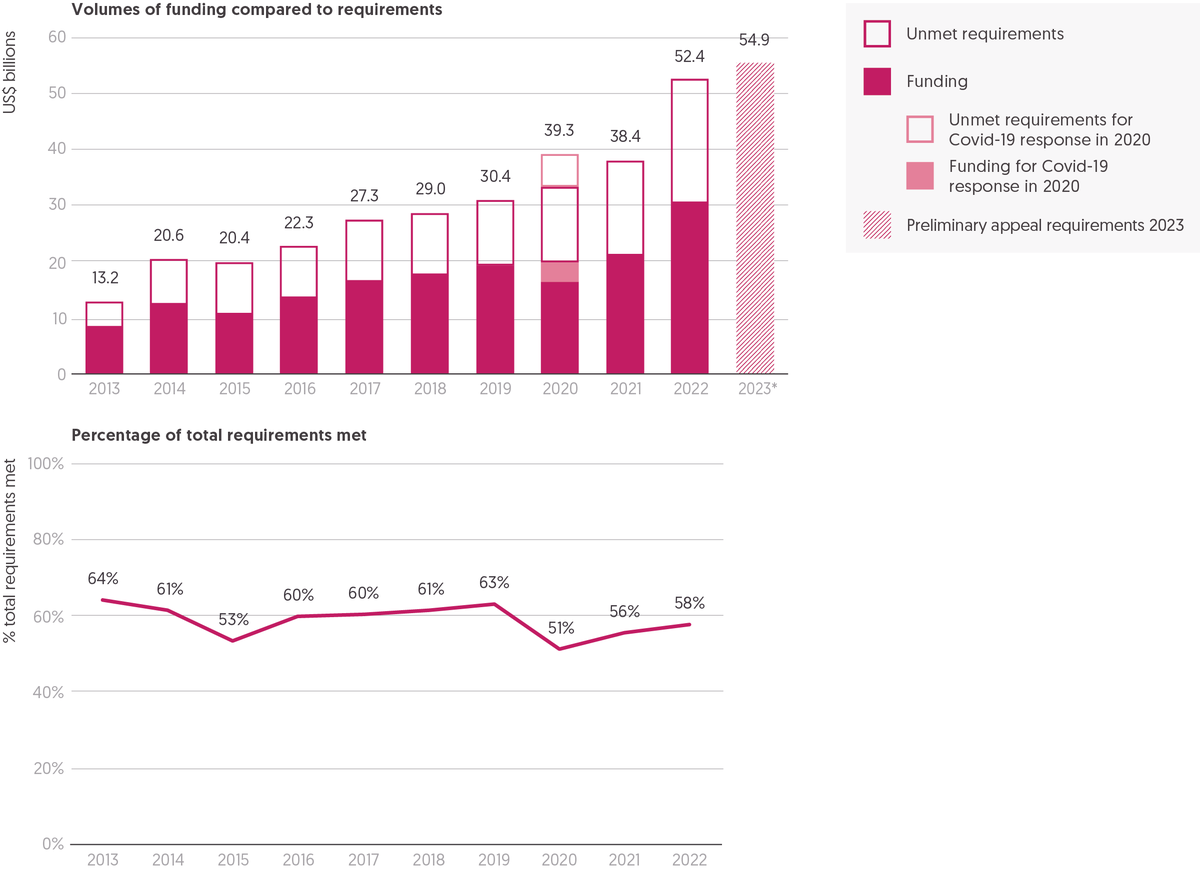
Stacked column chart showing rapid growth in requirements between 2021–2023, with line chart showing that the percentage of requirements met has not exceeded 60% since 2019.
Source: Development Initiatives based on UN Office for the Coordination of Humanitarian Affairs (OCHA) Financial Tracking Service (FTS), UN High Commissioner for Refugees (UNHCR) and Syria 3RP financial dashboard data.
Notes: Data is in current prices. 2023 data is preliminary in terms of total requirements as of April 2023. Figures for the breakdown of funding and requirements in 2023 to date are not visualised because the funding data is partial and continuously changing at the time of writing. [4] The percentage of requirements met in 2020 includes all funding, for Covid-19 and other responses, against all requirements that year.
The UN-coordinated appeals process is designed to provide a strategic approach to financing humanitarian action by collating together the funding required by UN agencies and NGOs to meet humanitarian needs in major crises.
In 2022, the scale of the funding required to meet humanitarian needs globally jumped to a record high, which looks to be surpassed in 2023 according to preliminary data. The systemic shock of the Covid-19 pandemic had already driven an unprecedented rise in funding requirements within humanitarian appeals in 2020 and 2021, however new and worsening crises in Ukraine, Afghanistan and the Horn of Africa led to a significant increase in the volumes of humanitarian assistance required in 2022. While funding to appeals grew significantly as a result, the scale of needs meant that the proportion of requirements met in 2022 only slightly increased compared to 2021, and the overall funding shortfall grew in absolute terms to US$22.1 billion – the highest volume recorded.
- A record total of US$52.4 billion was requested through UN-coordinated appeals in 2022. Funding requirements for UN-coordinated appeals in 2023 have already overtaken this, which to date stand at US$54.9 billion – around 40% more than requirements in 2020 and 80% more than requirements in 2019 before the Covid-19 pandemic.
- Funding in 2022 was required to meet the needs identified through 46 UN-coordinated appeals, compared to 48 appeals in 2021 and 55 in 2020. However, the number of appeals remains notably higher than 2019 (36).
- The Russian invasion of Ukraine led to the creation of a new flash appeal and a new regional response plan. Other new response plans in 2022 included for the Pakistan floods, the Super Typhoon Rai (Odette) in the Philippines, and for the multidimensional socioeconomic crisis in Sri Lanka.
- Two longstanding humanitarian appeals, in Libya and Iraq, were discontinued after 2022 following eight and nine years, respectively. These transitioned into development-focused assistance frameworks.
- The number of countries with UN appeals that are experiencing protracted or recurrent crisis is growing. In 2022, 44 countries had UN-coordinated appeals for five years or more compared to 36 countries in 2021. This continues to increase with 52 countries to date in 2023 experiencing protracted crisis, partly due to the Venezuela Regional Refugee and Migrant Response Plan entering its fifth year and also due to increasingly protracted UN-coordinated responses in Zambia and Mozambique. This represents an almost four-fold increase in the number of countries (14) in protracted crisis since 2014.
Appeal requirements
The sharp increase in financial requirements for UN-coordinated appeals in 2022 and 2023 was primarily driven by additional crisis shocks in countries that were facing pre-existing humanitarian needs.
- Funding requested through UN appeals in 2022 increased by 37% from 2021 (an increase of US$14.0 billion). Funding requirements have increased nearly fourfold since 2013, from US$13.2 billion to US$52.4 billion.
- In total, 14 appeals in 2022 had requirements of over US$1.0 billion, compared to 4 appeals in 2013.
- Looking forwards, appeal requirements for 2023 have already surpassed those for 2022 with at least, to date, a 4.8% (US$2.5 billion) growth in funding requirements recorded.
- Funding requirements to respond to the regional Syria crisis remain the highest. In 2022, the Syrian Refugee Regional Response Plan (3RP) had an appeal of US$6.1 billion (9.0% increase from 2021) and the Syria Humanitarian Response Plan (HRP) had an appeal of US$4.4 billion (5.2% increase from 2021).
- The overall growth in funding requirements was driven by the combined appeal requirements for the Ukraine response in 2022, which stood at US$5.9 billion of additional funding. While a HRP already existed in Ukraine prior to that for people affected by conflict in Donetska and Luhanska, the requirements of the response within Ukraine rose sharply from US$168 million in 2021 to US$4.3 billion in 2022. A regional response plan for the Ukraine crisis was newly formed in 2022, requesting an additional US$1.8 billion.
- The humanitarian response requirements for Afghanistan tripled to US$4.4 billion in 2022, from US$1.5 billion in 2021, partly reflecting the severe impact the reduction in international development assistance has had on humanitarian needs.
- The conflict in the north of Ethiopia and droughts in the south led humanitarian response requirements to more than double to US$4.0 billion in 2023, from US$1.5 billion in 2021.
- The longest and most severe drought in Somalia’s recorded history led humanitarian actors to request US$2.6 billion in 2023, more than double the amount in 2021 (US$1.1 billion).
Funding commitments to appeals
There was a significant response from donors to the growth in appeal requirements, with a large increase in funding committed to appeals in 2022. The proportion of overall requirements met therefore increased, inching closer to pre-Covid-19 levels. Despite this, the large increase in overall requirements meant the overall humanitarian funding gap grew in absolute terms to historic volumes.
- Donors provided a record US$30.3 billion of funding towards UN-coordinated appeals in 2022, an increase of more than 40% (US$8.9 billion).
- Despite this rise in funding, the volume of appeal requirements unmet in 2022 increased to US$22.1 billion, from US$17.0 billion in 2021 (30% increase). This is an alarming increase compared to between 2013 and 2019 – before the Covid-19 pandemic – when the volume of unmet funding requirements stood on average at US$9.2 billion. The funding gap in 2022 nearly doubled since 2019, before the Covid-19 pandemic.
- In 2022, 58% of funding requirements globally were met, increasing for a second year in a row since the 2020 drop to 51%. However, this still remains below the average of 61% between 2013 and 2019.
- This surge in appeal funding in 2022 was mostly driven by the top three donors: the US, Germany and EU institutions, meaning the share of funding to UN-coordinated response plans provided by these donors increased further, from 59% in 2021 to two-thirds (66%) of all funding in 2022.
- The US increased funding to UN-coordinated response plans in 2022 by 72% (US$5.9 billion), while Germany and EU institutions both increased their contributions to those plans by around half. This meant the US alone provided almost half (48%) of all funding to UN-coordinated appeals in 2022.
The proportion of funding requirements met differed between appeals, although with slightly less variation than in 2021.
- In 2022, about a third (18 of 46) of appeals received 50% or less of their requested funding, compared to nearly half of appeals in 2021.
- Of the 46 appeals in 2022, 10 received more than 75% of requirements, the highest of which was the Regional Migrant Response Plan for the Horn of Africa and Yemen (97%). Two appeals were funded at less than 25% (the Haiti Cholera Flash Appeal and the Cuba Hurricane Ian response), fewer than the five funded at this level in 2021.
- The appeals that received the highest volume of funding were the Ukraine Flash Appeal (US$3.7 billion, 85%), the Afghanistan HRP (US$3.2 billion, 73%) and the Syria 3RP (US$2.4 billion, 39%).
- As well as the Ukraine Flash Appeal and the Afghanistan HRP, the best funded appeals that had requirements over US$1.0 billion were the Somalia HRP (US$1.9 billion, 85%) and the Ukraine Regional Refugee Response Plan (US$1.3 billion, 74%). The least well-funded appeal with requirements of over US$1.0 billion was the South Sudan Regional RRP (US$361.6 million, 30%). (See Figure 2.2, Chapter 2 )
The funding to appeals in countries with protracted crises also fluctuated significantly, with trends differing between appeals.
- The largest fluctuation in requirements met within appeals that have existed for at least 10 years in 2022 was for the Haiti HRP and the Central African Republic HRP. Haiti funding fluctuated between 12% in 2018 to 80% in 2014 and Central African Republic ranged from 37% coverage in 2016 to 96% in 2022.
- The protracted crisis appeals in 2022 with the largest year-on-year fluctuations since they began were the Pakistan and Libya appeals, which both saw average year-on-year changes in appeal requirements met of 30% or more, both up and down. Funding to the Pakistan appeal ranged from US$58 million (29% coverage) in 2019 to US$344 million (104%) in 2021, while the Libya appeal’s funding ranged from US$78 million (25% coverage) in 2018 to US$137 million (105%) in 2020.
- The largest changes in the coverage of appeals between 2021 and 2022 for countries experiencing protracted crisis were for the Myanmar appeal, which fell from 85% (US$235 million in funding received) of requirements met to 42% (US$343 million), and the Pakistan appeal, which fell from 104% (US$344 million) to 71% (US$333 million), both due to funding not being able to match increases in requirements. The largest increases in coverage were for the Ukraine appeal, which increased from 61% (US$102 million in funding received) of requirements met in 2021 to 85% (US$3.7 billion) in 2022, and the Chad appeal, which increased from 36% (US$221 million) to 61% (US$309 million).
Red Cross Red Crescent appeals
The International Red Cross and Red Crescent Movement sets out its requirements separately from UN-coordinated appeals. In 2022, the International Federation of Red Cross and Red Crescent Societies (IFRC) appeal requirements increased by almost two-thirds (65%), driven by the large emergency appeal for Ukraine. The appeal from the International Committee of the Red Cross (ICRC) was larger and saw record contributions from donors, with 90% (US$2.4 billion) of its 2022 requirements covered.
IFRC emergency appeals relate mostly to disasters associated with natural hazards.
- In 2022, IFRC appeal requirements increased to US$2.1 billion, a 65% increase from 2021 (US$1.3 billion). [5]
- Funding to the IFRC increased by almost half (49%): from US$738 million in 2021 to US$1.1 billion in 2022.
- The proportion of requirements met fell slightly in 2022 (53%) from 2021 (59%). [6]
- The largest IFRC emergency appeal was for Ukraine, with US$576 million requirements and 71% (US$409 million) coverage. Excluding Ukraine, overall IFRC appeals coverage in 2022 was 46%.
ICRC appeals respond mainly to conflict-related situations.
- ICRC appeal requirements in 2022 increased by 15%, from US$2.3 billion to US$2.7 billion.
- Contributions toward ICRC appeals increased by 22%, from US$2.0 billion in 2021 to US$2.4 billion in 2022 – covering 90% of funding requirements. [7] Since 2014, coverage has averaged 89%. Total ICRC funding is expected to fall in 2023, as cuts of US$450 million were announced by the board in March 2023. [8]
Figure 1.5: Nearly all the top 20 donors increased contributions in 2022
20 largest public donors of humanitarian assistance in 2022 and change from 2021
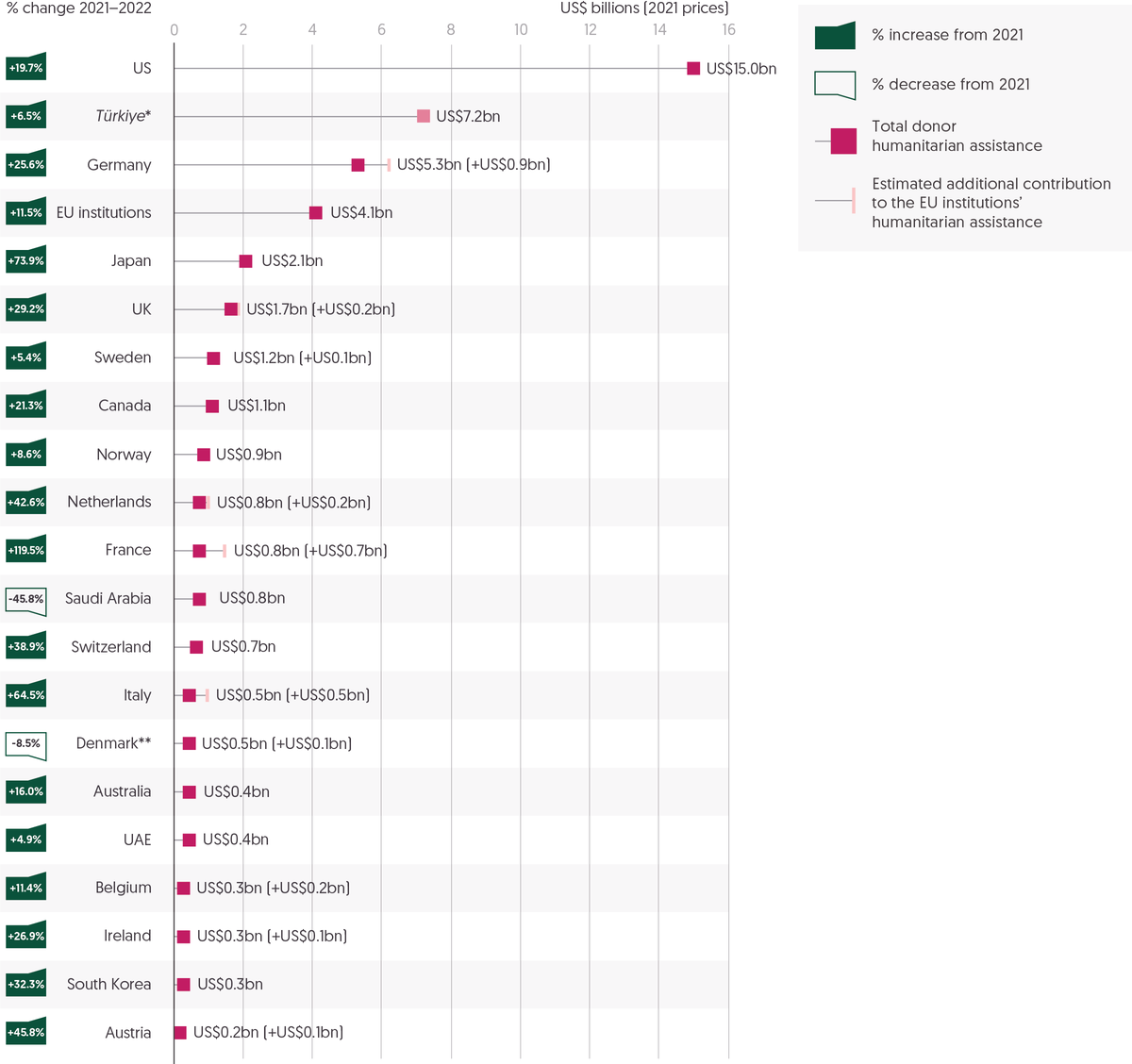
Bar chart showing volumes of humanitarian assistance from the 20 largest donors, with the US at the top. Also shows percentage increase or decrease from 2021.
Source: Development Initiatives based on Organisation for Economic Co-operation and Development (OECD) Development Assistance Committee (DAC), UN Office for the Coordination of Humanitarian Affairs (OCHA) Financial Tracking Service (FTS), UN Central Emergency Response Fund (CERF), and Turkish Cooperation and Coordination Agency (TIKA).
Notes: UAE = United Arab Emirates. 2022 data is preliminary. Data is in constant 2021 prices. ‘Public donors’ refers to governments and EU institutions. Contributions of current and former EU member states to EU institutions’ international humanitarian assistance is shown separately (see our online ‘Methodology and definitions’, Chapter 5). Percentage change excludes EU contributions and compares for donors with 2022 volumes based on only FTS data with 2021 volumes from the same source and according to the same methodology. *Türkiye is shaded differently because the humanitarian assistance it voluntarily reports to the DAC is largely expenditure on hosting Syrian refugees within Türkiye, and so not strictly comparable with the international humanitarian assistance from other donors in this figure. ** Preliminary 2022 figures for Denmark have only been partially reported and are likely to be revised upwards in final reporting at the end of 2023. 2021 figures differ from the GHA Report 2022 due to final reported international humanitarian assistance data.
The unprecedented growth in the volumes of funding required to meet humanitarian needs in 2022 (see Figure 1.4 ), and the particularly strong donor response to the humanitarian impacts of the Russian invasion of Ukraine, led to a significant increase in funding from public donors.
- In total, international humanitarian assistance from public donors grew from US$30.1 billion in 2021 to US$38.1 billion in 2022 (see Figure 1.3 ), an increase of 27%.
- Nearly all (18) of the top 20 public donors of international humanitarian assistance increased their contributions in 2022 from 2021. An unprecedented number made large increases in their contributions, with over half (11) increasing assistance by more than 20%.
- On average, funding from the top 20 donors increased by 27% in 2022. This marks a significant departure from 2021 when funding increased on average by 11%.
- The public donor base has not broadened. The top 20 donors accounted for nearly all public funding, representing 97% (US$37.2 billion) of total public resources, a similar share as in 2021 (98%).
Following a somewhat static funding base over the past decade, 2022 saw notable changes among the top donors as Germany overtook EU institutions to become the second largest public donor and Japan overtook the UK as the fourth largest. [9] Overall, the humanitarian system remains dependent on a small number of key donors, especially the US and Germany, which both significantly increased funding in 2022.
- In 2022, the largest donors provided the largest increases in funding by volume. The largest increases were from the US, which provided US$15.0 billion (an increase of US$2.5 billion, up 20%), Germany, which provided US$5.3 billion (up US$1.1 billion, 26%) and Japan, which provided US$2.1 billion (up US$0.9 billion, 74%). Funding from the third largest public donor, EU institutions, grew by US$0.4 billion, a 12% rise to US$4.1 billion.
- The three largest public donors – US, Germany and EU institutions – together accounted for 64% of total international humanitarian assistance from public donors, with the US alone accounting for 39% of total assistance from public donors.
- Despite an increase in allocations from the UK, up 29% in 2022 to US$1.7 billion, cuts in 2020 and 2021 mean it remains outside the top three largest government donors. In 2022, the UK’s share of contributions accounted for 4.6% of total funding from public donors, compared to 10% in 2019.
- Other notable increases in funding came from France, which more than doubled its contributions from US$358 million in 2021 to US$785 million in 2022 (up 119%), Italy, which increased its humanitarian assistance by 64% to US$493 million and the Netherlands, which increased funding by 43% in 2022 to US$803 million.
The conflict in Ukraine led to a significant increase in the number of refugees hosted by countries which also provide humanitarian assistance. These countries can report some of their spending in the first year of hosting refugees as ODA to the OECD DAC. [10]
In 2022, donor spending on hosting refugees in-country more than doubled to a record high driven by the conflict in Ukraine.
- In 2022, the preliminary reported ODA spent on in-country refugee hosting costs by DAC members grew to a record US$30.1 billion, from US$12.8 billion in 2021 (an increase of 134%). Spending in 2022 on hosting refugees in DAC member countries therefore significantly exceeded the previous annual high in 2016 (US$18.6 billion).
- Six countries increased their expenditure on in-country refugee hosting in 2022 by more than US$1 billion. The largest increase was seen by the UK, which more than tripled spending to US$4.8 billion in 2022 from US$1.4 billion in 2021. Other notable increases were seen in Poland (from US$17 million to US$2.3 billion), Germany (from US$2.7 billion to US$4.8 billion), the US (from US$4.7 billion to US$6.2 billion), Ireland (from US$50 million to US$1.3 billion) and Italy (from US$556 million to US$1.6 billion).
- Several other countries saw significant increases in expenditure on hosting refugees from Ukraine, most of whom had spent minimal amounts on in-country refugee hosting in previous years: Japan (from US$0.27 million to US$61 million), the Czech Republic (from US$6.4 million to US$640 million) and Lithuania (from US$1.9 million to US$48 million).
- In 2022 and according to preliminary data, Poland hosted the highest number of people seeking asylum, including Ukrainian refugees (1.6 million), at an estimated per person cost of US$1,455, followed by Germany (1.2 million people) at an estimated per person cost of US$4,134. In comparison, three European donors were estimated to have spent over US$15,000 per person while hosting significantly fewer people seeking asylum: Switzerland hosted 85,000 people at a per person cost of US$15,099, Ireland hosted 77,000 people at a per person cost of US$17,326 and the UK hosted 188,000 people at a per person cost of US$25,717. [11]
- As a result, the average proportion of total ODA spent on in-country refugee hosting by DAC donors increased from 4.7% in 2021 to 18% in 2022. In total, six donors allocated more than 25% of total ODA to refugee hosting within their own country: Poland (67%), the Czech Republic (65%), Ireland (54%), the UK (31%), Switzerland (29%) and Finland (27%).
Figure 1.6: A growing number of donors provided more than 0.1% of GNI as humanitarian assistance in 2022
20 largest government donors of international humanitarian assistance by % GNI
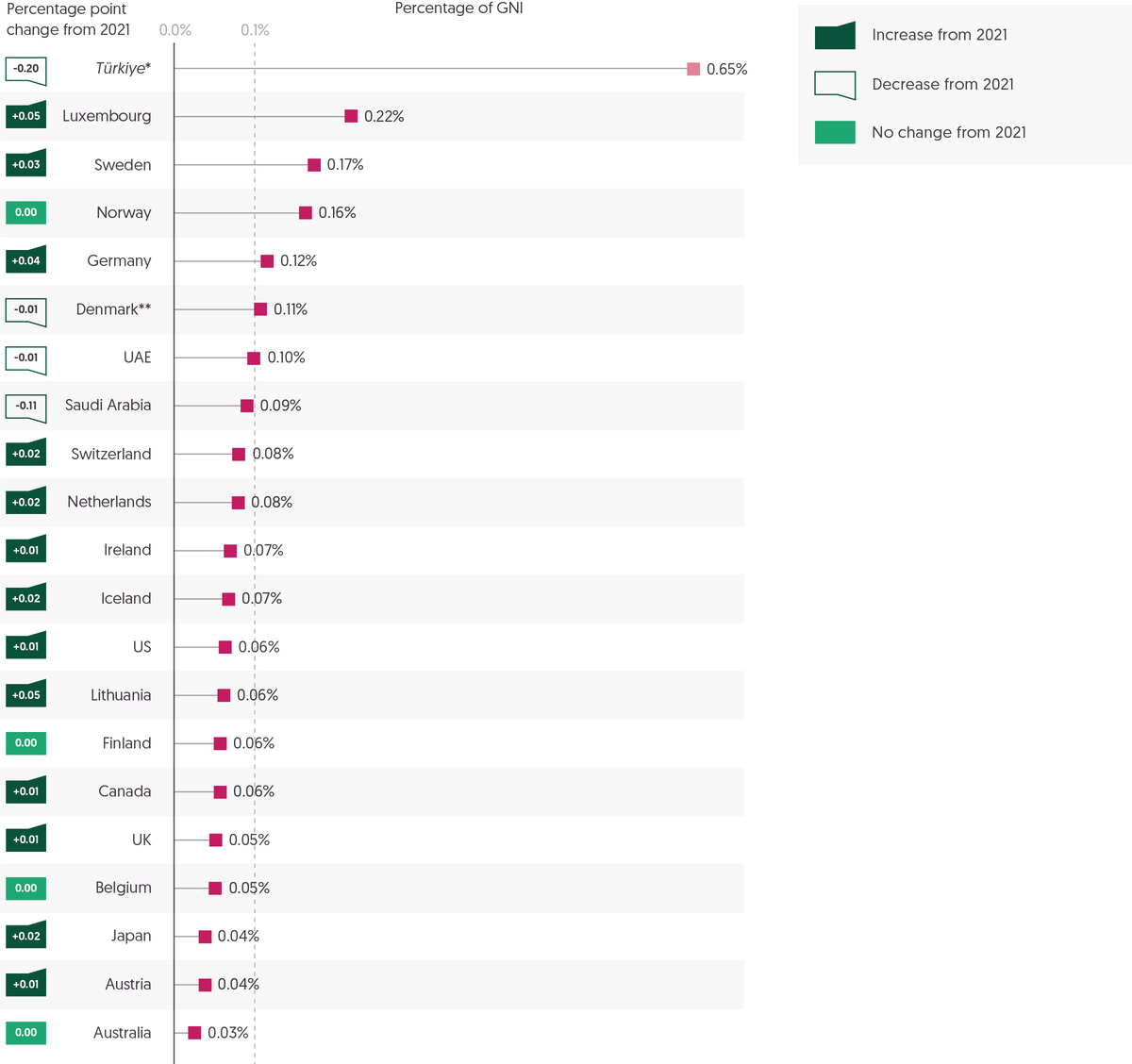
Bar chart showing humanitarian assistance as percentage of GNI with average trend line at 0.1%. Also shows percentage increase or decrease from 2021.
Source: Development Initiatives based on Organisation for Economic Co-operation and Development (OECD) Development Assistance Committee (DAC), and UN Central Emergency Response Fund (CERF).
Notes: 2022 data is preliminary. EU institutions are not shown due to no comparable gross national income (GNI) figure. Government figures exclude EU contributions. *Türkiye is shaded differently because the humanitarian assistance it voluntarily reports to the DAC is largely expenditure on hosting Syrian refugees within Türkiye, and so not strictly comparable with the international humanitarian assistance from other donors in this figure. ** Preliminary 2022 figures for Denmark have only been partially reported and are likely to be revised upwards in final reporting at the end of 2023. Figures for 2021 differ from the GHA Report 2022 due to final reported international humanitarian assistance data and revised GNI figures.
The growing humanitarian funding gap is exacerbated by the narrow donor base the system relies on. There is a need to both diversify the number of funding sources and move towards greater responsibility-sharing. One metric to assess the extent to which public donors prioritise humanitarian responses is the proportion of GNI committed to it. In 2022, most donors increased the proportion of GNI provided as humanitarian assistance in line with overall increases in volume, but the share of GNI continues to vary greatly among donors.
- Of the 20 government donors that provided the largest volume of international humanitarian assistance as a percentage of GNI in 2022, 12 increased this proportion, compared to 7 in 2021.
- Six government donors allocated 0.1% or more of their GNI to humanitarian responses in 2022 (Luxembourg, 0.22%; Sweden, 0.17%; Norway, 0.16%; Germany, 0.12%, Denmark, 0.11% and the United Arab Emirates (UAE), 0.10%). This is one more than in 2021.
- Türkiye also reported an equivalent of 0.65% of its GNI as humanitarian assistance in 2022, down from 0.85% in 2021. Türkiye’s reported contributions are not directly comparable with those of other donors, however, as the assistance voluntarily reported to the OECD DAC largely comprises spending on hosting Syrian refugees within Türkiye.
- The largest increases of humanitarian funding in terms of GNI came from Lithuania and Luxembourg (both +0.05 percentage points) and Germany (+0.04 percentage points).
- The most notable reduction among the top 20 government donors in terms of their humanitarian contributions relative to GNI in 2022 was from Saudi Arabia, which was ranked the highest in 2021 (0.20%) and fell to 0.09% in 2022 (-0.11 percentage points).
- The large increase in funding provided by the US in 2022 is reflected in the share of GNI provided as humanitarian assistance, which has risen to 0.06%. This now places the US ahead of other large donors, the UK (0.05%) and Japan (0.04%), but behind 11 other donors.
- There are also notable high-income countries outside of the top 20 government donors that contribute a relatively small proportion of their GNI to international humanitarian assistance. In 2022, this included: France (fifth highest GNI, providing 0.03%), Italy (sixth highest GNI, providing 0.02%), Korea (eighth highest GNI, providing 0.01%) and Spain (tenth highest GNI, providing 0.01%).
Insight
Jan Egeland
Jan Egeland has been Secretary General of the Norwegian Refugee Council since August 2013, leading humanitarian operations with some 16,000 relief workers, serving over 9 million people in need across the world. In June 2021, he was appointed Eminent Person of The Grand Bargain initiative. Within this role he is responsible for promoting and advocating for the advancement of The Grand Bargain’s commitments to better serve people in need. Egeland served as UN Under-Secretary-General for Humanitarian Affairs and Emergency Relief Coordinator 2003 – 2006 where he spearheaded a reform of the global humanitarian system.
Over the past 10 years, humanitarian needs have grown exponentially. In 2023, the total requirements for UN-coordinated humanitarian responses globally will be more than five times as large as in 2013. Requirements will be 40% larger than during 2020, a year that was marked by a steep increase in needs due to the Covid-19 pandemic.
While donor funding has grown substantially, the system continues to rely on the generosity of a handful of Western donors, with the US, Germany, and the EU contributing two-thirds of all humanitarian assistance. Furthermore, these resources are unequally distributed, with some countries becoming caught in a cycle of neglect.
At the same time, the number of countries facing protracted crises has grown. In the past twelve months, I have visited Afghanistan, Niger, Somalia, Ukraine, Bangladesh and Palestine, and witnessed large communities engulfed in never-ending war, strife and disasters.
The gap between needs and available funding continues to widen and the system is under increasing pressure. We simply cannot keep up. So, how do we fix it?
Over the past two years, I have chaired the work of the Grand Bargain, a unique platform that brings together donors, UN agencies, the Red Cross Red Crescent (RCRC) movement, international NGOs and local actors with the aim of making humanitarian action more effective and efficient. We have pursued this aim through a focus on predictable and flexible funding, through localised humanitarian action, and through better communication with those affected. This emphasis on improving the delivery of aid and finding durable solutions to vulnerability and displacement is one of the tools in our toolbox as we try to keep up with increasing needs and the growing funding gap. But it cannot – and should not – be the only one.
We cannot close the funding gap without shrinking the needs in the first place. We must work on finding political solutions to the many crises and convince our leaders to invest their political capital to solve them. At the same time, we need to find ways to help people to emerge from displacement and re-establish themselves in safe and lasting communities. Humanitarians cannot do this alone – we need development actors and international financial institutions to step up their game.
To be successful, we need new players on board with us. We can get them by gaining broader support for humanitarian action. Humanitarian assistance is not solely philanthropically motivated – we should change our narrative and discuss the benefits of humanitarian assistance as an investment in resilience and stability for a global common good. This could motivate more states to step up their support to humanitarian (and development) funding. If we look back to 2020, the entire humanitarian budget we requested – US$39 billion – represented less than 0.1% of the 57 highest-income countries' gross national income (GNI). In other words, had each of these countries contributed a fraction of a percent of its GNI to humanitarian assistance, all the funding needed to respond to international humanitarian crises would have been available.
Read our latest report on humanitarian finance and reform
Our new report 'Falling short? Humanitarian funding and reform' presents the latest data on global humanitarian assistance, as well as progress on Grand Bargain localisation targets, cash and voucher assistance, and anticipatory action.
Read the reportDownloads
Notes
-
1
'Protracted crises’ refer to countries which have had UN-coordinated country response plans or country components of regional response plans for at least five consecutive years in 2022.Return to source text
-
2
EU institutions, as defined by the OECD DAC, includes the European Commission (and all sub-entities including DG ECHO and DG INTPA), the European External Action Service, and the European Investment Bank. For more detail see: https://www.oecd-ilibrary.org/sites/c0ad1f0d-en/index.html?itemId=/content/component/5e331623-en& csp =b14d4f60505d057b456dd1730d8fcea3&itemIGO=oecd&itemContentType=chapterReturn to source text
-
3
This is based on Development Initiatives’ methodology combining both DAC and FTS data. Using only preliminary DAC data, the proportion of international humanitarian assistance of total ODA in 2022 is 12%, though this data on humanitarian funding is likely to be revised upwards in December 2023.Return to source text
-
4
Up to date information on funding and requirements of UN-coordinated response plans in 2023 tracked by FTS is available at: https://fts.unocha.org/appeals/overview/2023Return to source text
-
5
This figure represents requirements for all IFRC emergency appeals active in 2022, including requirements for appeals that were opened in previous years and still active in 2022, and appeals that might continue into the future.Return to source text